
Kensal Green Cemetery is a cemetery in the Kensal Green area of North Kensington in the Royal Borough of Kensington and Chelsea and the London Borough of Hammersmith and Fulham in London, England. Inspired by Père Lachaise Cemetery in Paris, it was founded by the barrister George Frederick Carden. The cemetery opened in 1833 and comprises 72 acres (29 ha) of grounds, including two conservation areas, adjoining a canal. The cemetery is home to at least 33 species of bird and other wildlife. This distinctive cemetery has memorials ranging from large mausoleums housing the rich and famous to many distinctive smaller graves and includes special areas dedicated to the very young. It has three chapels and serves all faiths. It is one of the Magnificent Seven cemeteries in London.

Brompton Cemetery is since 1852 the first London cemetery to be Crown property, managed by The Royal Parks, in West Brompton in the Royal Borough of Kensington and Chelsea. It is one of the Magnificent Seven cemeteries. Established by Act of Parliament and laid out in 1839, it opened in 1840. Consecrated by Charles James Blomfield, Bishop of London, in June 1840, it is one of Britain's oldest and most distinguished garden cemeteries. Some 35,000 monuments, from simple headstones to substantial mausolea, mark more than 205,000 resting places. The site includes large plots for family mausolea, and common graves where coffins are piled deep into the earth. It also has a small columbarium, and a secluded Garden of Remembrance at the northern end for cremated remains. The cemetery continues to be open for burials. It is also known as an urban haven for nature. In 2014, it was awarded a National Lottery grant to carry out essential restoration and develop a visitor centre, among other improvements. The restoration work was completed in 2018.

Key Hill Cemetery, originally called Birmingham General Cemetery, is a cemetery in Hockley, Birmingham, England. It opened in 1836 as a nondenominational cemetery, and is the oldest cemetery, not being in a churchyard, in Birmingham. The principal entrance is on Icknield Street to the west, with a secondary entrance on Key Hill to the north. The cemetery contains the graves of many prominent members of Birmingham society in the late 19th century, to the extent that in 1915 E. H. Manning felt able to dub it "the Westminster Abbey of the Midlands".
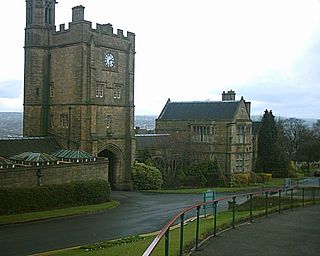
The City Road Cemetery is a cemetery in the City of Sheffield, England that opened in May 1881 and was originally Intake Road Cemetery. Covering 100 acres (40 ha) it is the largest and is the head office for all the municipally owned cemeteries in Sheffield. The cemetery contains Sheffield Crematorium, whose first cremation was on 24 April 1905.

Crookes Cemetery is a cemetery between Crosspool and Crookes in the city of Sheffield, South Yorkshire, England. Its main entrance is on Headland Road with additional access from Mulehouse Road. It was opened in 1906, and covers 29 acres (120,000 m2). By 2009, over 29,000 burials had taken place since its opening.
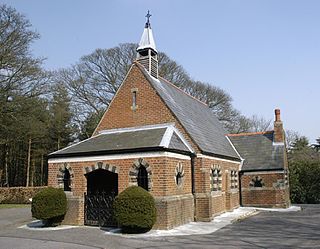
Aldershot Military Cemetery is a burial ground for military personnel, or ex-military personnel and their families, located in Aldershot Military Town, Hampshire.
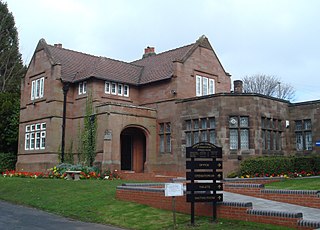
Lodge Hill Cemetery is a municipal cemetery and crematorium in Selly Oak, Birmingham, England. The cemetery was first opened by King’s Norton Rural District Council in 1895, and during the 1930s became the site of Birmingham's first municipal crematorium.

The cemetery has had various titles including The Cemetery by the Common, Hill Lane Cemetery and is currently known as Southampton Old Cemetery. An Act of Parliament was required in 1843 to acquire the land from Southampton Common. It covers an area of 27 acres (11 ha) and the total number of burials is estimated at 116,800. Currently there are 6 to 8 burials a year to existing family plots.

Bishopwearmouth Cemetery is a cemetery in Sunderland, Tyne and Wear, England. It lies between Hylton Road and Chester Road.

Southern Cemetery is a large municipal cemetery in Chorlton-cum-Hardy, Manchester, England, 3 miles (4.8 km) south of the city centre. It opened in 1879 and is owned and administered by Manchester City Council. It is the largest municipal cemetery in the United Kingdom and the second largest in Europe.

Locksbrook Cemetery is a municipal cemetery located in Lower Weston, Bath, England. It was opened in 1864 as Walcot Cemetery, and occupies 12 acres (4.9 ha), originally serving the parishes of Walcot, Weston and St Saviour's. The cemetery was closed for general use in 1937 with over 30,000 interments there, though additional burials in existing graves continue. The majority of the cemetery was for about 29,500 burials from Walcot parish, with the north of the cemetery for Weston and St Saviour parishes.

The Lye and Wollescote Cemetery is an active 9.45 acres (3.82 ha) cemetery in Lye, West Midlands, England.

The English coastal city of Brighton and Hove, made up of the formerly separate Boroughs of Brighton and Hove in East Sussex, has a wide range of cemeteries throughout its urban area. Many were established in the mid-19th century, a time in which the Victorian "cult of death" encouraged extravagant, expensive memorials set in carefully cultivated landscapes which were even recommended as tourist attractions. Some of the largest, such as the Extra Mural Cemetery and the Brighton and Preston Cemetery, were set in particularly impressive natural landscapes. Brighton and Hove City Council, the local authority responsible for public services in the city, manages seven cemeteries, one of which also has the city's main crematorium. An eighth cemetery and a second crematorium are owned by a private company. Many cemeteries are full and no longer accept new burials. The council maintains administrative offices and a mortuary at the Woodvale Cemetery, and employs a coroner and support staff.

Weaste Cemetery is a public cemetery in Weaste, Salford, Greater Manchester, in England. Opened in 1857, it is the oldest of Salford's four cemeteries, covering 39 acres and containing over 332,000 graves.
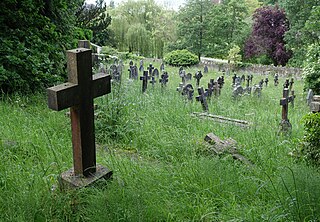
Smallcombe Cemetery is on the edge of Bath, Somerset, England, in a valley between Widcombe Hill and Bathwick Hill. It has two distinct parts, the Anglican section known as St Mary's Churchyard and the nonconformist section known as Smallcombe Vale cemetery; they are sometimes known together as Smallcombe Garden cemetery. The two cemeteries have been closed to new burials since 1988 and are maintained by Bath and North East Somerset Council. The Bath Corporation had assumed responsibility for both cemeteries in 1947.

Earlham Road Cemetery, Norwich also known as Earlham Cemetery or Norwich Cemetery is a cemetery located in Norwich which was officially opened on 6 March 1856 and covers 34 acres (14 ha). The cemetery is divided into two distinct sites by Farrow Road A140 which runs north–south across the site. To the east of the road is the original 19th century cemetery and to the west of the road lies the 20th century addition. Today, it caters for all faiths with separate burial grounds and chapels for Jews and Catholics and a growing one for Muslims together with two military cemeteries. The 19th century cemetery is designed with an informal garden cemetery layout with winding paths while the remainder is a more formal grid type which was favoured by cemetery designer John Claudius Loudon. Much of the original cemetery is a County Wildlife Site and contains grassland and a wide selection of mature trees.
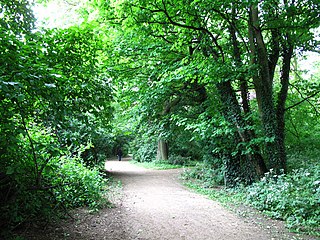
Hull General Cemetery was established by a private company in 1847 on Spring Bank in the west of Kingston upon Hull, East Riding of Yorkshire, England. In 1862 the Hull Corporation established a cemetery adjacent, now known as Western Cemetery, and in c. 1890 expanded the cemetery west across Chanterlands Avenue onto an adjacent site.

Tiverton Cemetery is the burial ground for the town of Tiverton in Devon. The cemetery covers eight acres and is owned and maintained by Mid Devon Council.
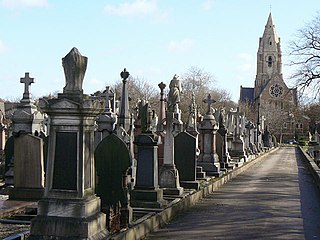
Church Cemetery, also known as Rock Cemetery, is a place of burial in Nottingham, England which is Grade II* listed. It is situated at the south-east corner of Forest Recreation Ground.

Nottingham Road Cemetery is a municipal cemetery in Chaddesden, an inner suburb of Derby, in central England. It was established in 1855 to provide more burial capacity for the rapidly growing town.






















